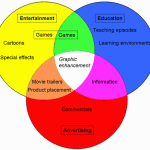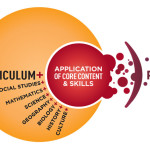K-12 Curriculum Analysis & Development
Curriculum development could be the most fluid element in contemporary K-12 education. Innovative teaching and learning methodologies such as Personalized/Blended-based Learning; Authentic Learning; Andragogical (adult) Learning; and Competency-based Learning are driving a redefinition of just what today’s curriculums should look like. i-pel relies on the education philosophy of Innovationism to guide the evaluation and development of all K-12 curriculum and support materials using a balanced format of objective and subject content.
Motivation and Engagement Factor
All curriculum projects, like all aspects of i.pel activities, are looked at through the lens of motivation and engagement (see: Achievement Motivation and Engagement). Since all learning is based on three aspects of engagement: Emotion; Reflection; and Action (Steiner, 1921) we first start with the “Emotional” element. In order to attract initial student interest all i-pel curriculum is interspersed with entertainment elements including riddles, mysteries and humor (see: Motivation & Engagement-based eLearning and Education Game-based eLearning). Within these element can be found serious pedagogical content. Thy not only provide initial inertia they also lead to the next phase of learning which is “Reflection” or as it’s commonly known “thinking.” The entertainment elements are designed to break-down student resistance to the learning process. The final “Action” phase of the learning process becomes the application basis of the K-12 Teaching and Learning Platforms such as project-based learning; personalized-based learning; competency-based learning; CTE-based learning; or standardized-based assessment learning.
(see: Motivation & Engagement-based eLearning and Education Game-based eLearning). Within these element can be found serious pedagogical content. Thy not only provide initial inertia they also lead to the next phase of learning which is “Reflection” or as it’s commonly known “thinking.” The entertainment elements are designed to break-down student resistance to the learning process. The final “Action” phase of the learning process becomes the application basis of the K-12 Teaching and Learning Platforms such as project-based learning; personalized-based learning; competency-based learning; CTE-based learning; or standardized-based assessment learning.
The extrinsic and intrinsic elements of motivation are prominent in all K-12 curriculum that i-pel analyzes and develops. As a student progresses through the grades, extrinsic motivations should decrease and be replaced with engaging and challenging learning materials that encourage a love of learning. i-pel designs curriculum programs which are unique in their intrinsic motivation. These programs are developed by the students themselves according to their personalized learning experience. In addition, they also create their own assessment programs both summative and formative. Since these programs are done within the allotted instructional time frames they are in and of themselves their own learning experience as well as an integrated work experience. Since this program is done in a CTE format the student will get paid for doing this. (see: Intrinsic and Extrinsic Motivation)
Since one of Innovationism’s prime tenants and supporting theories is Andragogy which is the concept of adult learning. Since students are in formal education for about 20 years but will self educate for the next 60 to 70 years (and more than likely longer) it is important that the curriculum be structured in a creative, interesting and entertaining format that encourages life-long learning. The bottom line is to train students to educate themselves (see: Student Agency through Adult Learning Theory).
Curriculum Basics
There are two types of curriculum. “Core,” or what is commonly called “basal,” curriculum and “supplemental” curriculum. The core curriculum is the main carrier for content in a course and typically has a defined scope and sequence. Traditionally, the core was the textbook for the course, which often came with a variety of other materials, such as videos, software, and teacher professional development (see: K-12 Curriculum).
It was not unusual for curriculum development to go through a process that could take up to five years to complete. The stages include Planning; Review & Analysis; Program Development; Implementation; Practice & Documentation; and Evaluation (see: Curriculum Development Cycle). Because of the rapid changes in cognitive awareness brought on by technology this cycle has increased exponentially.
From Pre-k through the fifth grade student should be exposed to subject matter that is facts and information rich so they will be able to perform the critical thinking content components that will be required of them in middle school. Although knowledge accumulation continues throughout all of K-12, in high school student will be expected to express themselves creatively through innovative ways.
Integrative Instruction
i-pel curriculum, supplements and learning materials reinforces multi-disciplinary learning modules where “integrative instruction” is promoted throughout the school year (see: Objective and Subjective Teaching). Good teachers know that multi-disciplinary teaching and learning helps to connect subjects to the onslaught of real life experiences. Teachers use projects based on themes or class teaching plans that promote not only the knowledge of curriculum subjects but also “transversal competence” which are the abilities that students have to develop in order to solve new or unexpected problems and propose innovative solutions.
i-pel curriculum stresses three basic ideas:
- It invites teachers to combine subjects simultaneously or sequentially with the help of real-life subject matter
- Promotes cooperation, communication and coordination among teachers; and
- Promotes connections between theory, teaching and learning and the real life examples meaningful to students’ own reality and context
For example, a theme for a class or school year or school project may be “water” or “pollution.” Both themes include aspects studied by different subjects: chemistry, biology, natural resources, physics, mathematics, law, social sciences, etc. Another theme may be “art in the twentieth century”, and the subjects could be: art, history, social sciences, humanities, civilization. An integrative project for a student or school could be the production of a video, short film or feature film. In both cases, many subjects could be involved with teachers as guiding mentoring or in active engagement. An example close to full integrative teaching is what happens in multi-grade instruction.
Common Core Compliance
In the Common Core Reading Standards English Language Arts (ELA) the large majority of the Literacy Standards for History/Social Studies, Science, and Technical Subjects require that aligned curricula include high-quality questions and tasks that are text dependent. Such questions should encourage students to “read like a detective” by prompting relevant and central inquiries into the meaning of the source material that can be answered only through close attention to the text. The Literacy Standards therefore require students to demonstrate their ability to follow the details of what is explicitly stated, make valid inferences that logically follow from what is stated, and draw knowledge from the text. Student background knowledge and experiences can illuminate the reading but should not replace attention to the text itself. Integrated curricula provides opportunities for students to think critically; collaborate and cooperate with each other; and practice creativity and communications in a variety of formats (see: Common Core State Standards).
material that can be answered only through close attention to the text. The Literacy Standards therefore require students to demonstrate their ability to follow the details of what is explicitly stated, make valid inferences that logically follow from what is stated, and draw knowledge from the text. Student background knowledge and experiences can illuminate the reading but should not replace attention to the text itself. Integrated curricula provides opportunities for students to think critically; collaborate and cooperate with each other; and practice creativity and communications in a variety of formats (see: Common Core State Standards).
Working with State, district or school administrations i-pel provides in-depth curriculum analysis and development services.
Digital Integrated Curriculum
It has long been a concern with progressive educators that the cause of student failure is disenfranchisement more commonly known as boredom. In order to keep the K-12 student motivated and engaged their curriculum needs to be rigorous to be challenging but not to the point which causes students to lose interest (see: Digital & Ownership Motivation). This is why a curriculum entertainment element is so important. It’s what helps make learning fun and not a burden (see: above).
i-pel will be developing progressive Integrated Digital Curriculum content for contemporary K-12 online learning. Because technology has advanced the K-12 student’s knowledge and awareness past existing curriculums, i-pel intends to utilize the most advanced and current pedagogical developments in constructing eLearning environments. Although both rigorous and challenging, i-pel curriculum will be augmented with original or the latest interactive and media-savvy content which can be updated on literally a daily basis and can even up dated by the students themselves (see: Digital Curriculum Content Development).
Courses in core academic subjects, as well as, world languages, electives, honors, and advanced placements will be our primary focus. Courses will include integrated assessments and contain exempted pre-tests to allow students to skip content they have already learned and concentrate on the knowledge that needs work. Course-level assessments also will include tests for each course both in traditional and interactive formats.
Theme Immersions
Theme immersions are becoming very popular with personalized and authentic learning platforms (see: Innovation Education & Learning). They are a form of student-discovered curriculum. In this model the teacher gives the students several choice of a subject within a core curriculum. For example, the class might be studying the French Revolution and the teacher give the class a choice of researching how the people surveyed food shortages or how some people tried to escape. In essence there is not a formal curriculum as the students would have to do library and/or internet research. Using the internet to research is a good opportunity to integrate media literacy into a history lesson.
Career and Technical Education
Many school districts are now incorporating Career Technical Education as part of their core curriculum. i-pel also develops k-12 CTE courses such as:
- agriculture
- food
- natural resources
- architecture & construction
- business management & administration
- education & training
- finance
- health science
- hospitality & tourism
- information technology
- law, public safety, corrections & security
- manufacturing
- science, technology, engineering & mathematics
Since no one knows what the future holds and the fact that the average person changes careers (not just jobs) five times during their lifetime, these courses will be for both the student who doesn’t necessarily want to pursue a college career beyond community college certificate programs as well as the college bound student. These courses will be more in line with the innovative “Project-Based Learning” model (see K-12 Teaching and Learning Platforms). All courses will have a student payment component included with them.
Open Education Resources
In designing a K-12 curriculum program all resource are considered. For example, there are over 30,000 free K-12 instruction programs and material that are available through OER (see: Open Education Resources). i-pel is constantly developing and/or looking for the best K-12 content resources available.
Learning Challenged Curriculum
All LCC curriculums are developed through the learned aspects of the student’s disability such as the academic behavior and discipline science that has been studied over the past several decades (see: Executive Function & Academic Behavior and Motivation & Learning Disorders). A lot of these children respond favorably to creative curriculums tailored to their needs as opposed to drug treatments. For example, upon further analysis many child that have been diagnosed with non-clinical ADD are actually kinetic learners (see: Learning Theories).

Recent Comments